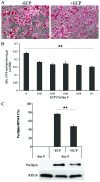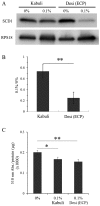Ethanol extracts of chickpeas alter the total lipid content and expression levels of genes related to fatty acid metabolism in mouse 3T3-L1 adipocytes
- PMID: 27353085
- PMCID: PMC4935453
- DOI: 10.3892/ijmm.2016.2654
Ethanol extracts of chickpeas alter the total lipid content and expression levels of genes related to fatty acid metabolism in mouse 3T3-L1 adipocytes
Abstract
Desi-type chickpeas, which have long been used as a natural treatment for diabetes, have been reported to lower visceral adiposity, dyslipidemia and insulin resistance induced by a chronic high-fat diet in rats. In this study, in order to examine the effects of chickpeas of this type in an in vitro system, we used the 3T3-L1 mouse cell line, a subclone of Swiss 3T3 cells, which can differentiate into cells with an adipocyte-like phenotype, and we used ethanol extracts of chickpeas (ECP) instead of chickpeas. Treatment of the 3T3-L1 cells with ECP led to a decrease in the lipid content in the cells. The desaturation index, defined as monounsaturated fatty acids (MUFAs)/saturated fatty acids (SFAs), was also decreased by ECP due to an increase in the cellular content of SFAs and a decrease in the content of MUFAs. The decrease in this index may reflect a decreased reaction from SFA to MUFA, which is essential for fat storage. To confirm this hypothesis, we conducted a western blot analysis, which revealed a reduction in the amount of stearoyl-CoA desaturase 1 (SCD1), a key enzyme catalyzing the reaction from SFA to MUFA. We observed simultaneous inactivations of enzymes participating in lipogenesis, i.e., liver kinase B1 (LKB1), acetyl-CoA carboxylase (ACC) and AMPK, by phosphorylation, which may lead to the suppression of reactions from acetyl-CoA to SFA via malonyl-CoA in lipogenesis. We also investigated whether lipolysis is affected by ECP. The amount of carnitine palmitoyltransferase 1 (CPT1), an enzyme important for the oxidation of fatty acids, was increased by ECP treatment. ECP also led to an increase in uncoupling protein 2 (UCP2), reported as a key protein for the oxidation of fatty acids. All of these results obtained regarding lipogenesis and fatty acid metabolism in our in vitro system are consistent with the results previously shown in rats. We also examined the effects on SCD1 and lipid contents of ethanol extracts of Kabuli-type chickpeas, which are used worldwide. The effects were similar, but of much lesser magnitude compared to those of ECP described above. Thus, Desi-type chickpeas may prove to be effective for the treatment of diabetes, as they can alter the lipid content, thus reducing fat storage.
Figures








Similar articles
-
Inhibition of stearoyl-CoA desaturase1 activates AMPK and exhibits beneficial lipid metabolic effects in vitro.Eur J Pharmacol. 2011 Dec 15;672(1-3):38-44. doi: 10.1016/j.ejphar.2011.09.172. Epub 2011 Sep 29. Eur J Pharmacol. 2011. PMID: 21970804
-
Adipogenesis, lipogenesis and lipolysis is stimulated by mild but not severe hypoxia in 3T3-L1 cells.Biochem Biophys Res Commun. 2016 Sep 16;478(2):727-32. doi: 10.1016/j.bbrc.2016.08.015. Epub 2016 Aug 4. Biochem Biophys Res Commun. 2016. PMID: 27498031
-
Stearoyl-CoA Desaturase-1 Protects Cells against Lipotoxicity-Mediated Apoptosis in Proximal Tubular Cells.Int J Mol Sci. 2016 Nov 9;17(11):1868. doi: 10.3390/ijms17111868. Int J Mol Sci. 2016. PMID: 27834856 Free PMC article.
-
Stearoyl-CoA desaturase--a new player in skeletal muscle metabolism regulation.J Physiol Pharmacol. 2006 Nov;57 Suppl 10:31-42. J Physiol Pharmacol. 2006. PMID: 17242489 Review.
-
Role of stearoyl-CoA desaturase-1 in skeletal muscle function and metabolism.Am J Physiol Endocrinol Metab. 2013 Oct 1;305(7):E767-75. doi: 10.1152/ajpendo.00268.2013. Epub 2013 Aug 13. Am J Physiol Endocrinol Metab. 2013. PMID: 23941875 Review.
Cited by
-
Nutrients and Oxidative Stress: Friend or Foe?Oxid Med Cell Longev. 2018 Jan 31;2018:9719584. doi: 10.1155/2018/9719584. eCollection 2018. Oxid Med Cell Longev. 2018. PMID: 29643982 Free PMC article. Review.
-
Ferulic Acid Stimulates Adipocyte-Specific Secretory Proteins to Regulate Adipose Homeostasis in 3T3-L1 Adipocytes.Molecules. 2021 Apr 1;26(7):1984. doi: 10.3390/molecules26071984. Molecules. 2021. PMID: 33915783 Free PMC article.
-
Dissecting the High Esterase/Lipase Activity and Probiotic Traits in Lactiplantibacillus plantarum B22: A Genome-Guided Functional Characterization.Foods. 2025 Jul 2;14(13):2354. doi: 10.3390/foods14132354. Foods. 2025. PMID: 40647106 Free PMC article.
-
In Vitro and In Vivo Nutraceutical Characterization of Two Chickpea Accessions: Differential Effects on Hepatic Lipid Over-Accumulation.Antioxidants (Basel). 2020 Mar 24;9(3):268. doi: 10.3390/antiox9030268. Antioxidants (Basel). 2020. PMID: 32214012 Free PMC article.
-
Metformin Protects against H2O2-Induced Cardiomyocyte Injury by Inhibiting the miR-1a-3p/GRP94 Pathway.Mol Ther Nucleic Acids. 2018 Dec 7;13:189-197. doi: 10.1016/j.omtn.2018.09.001. Epub 2018 Sep 6. Mol Ther Nucleic Acids. 2018. PMID: 30292140 Free PMC article.
References
-
- Kopelman PG. Obesity as a medical problem. Nature. 2000;404:635–643. - PubMed
MeSH terms
Substances
LinkOut - more resources
Full Text Sources
Other Literature Sources

